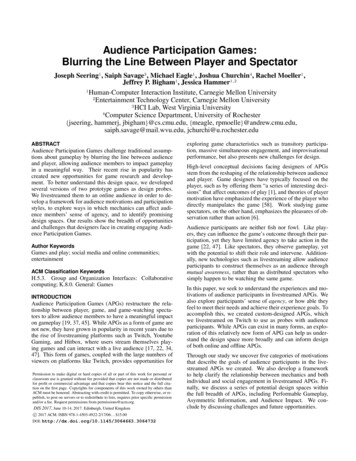
Transcription
Audience Participation Games:Blurring the Line Between Player and SpectatorJoseph Seering1 , Saiph Savage3 , Michael Eagle1 , Joshua Churchin4 , Rachel Moeller1 ,Jeffrey P. Bigham1 , Jessica Hammer1,21Human-Computer Interaction Institute, Carnegie Mellon University2Entertainment Technology Center, Carnegie Mellon University3HCI Lab, West Virginia University4Computer Science Department, University of Rochester{jseering, hammerj, jbigham}@cs.cmu.edu, {meagle, , jchurchi@u.rochester.eduexploring game characteristics such as transitory participation, massive simultaneous engagement, and improvisationalperformance, but also presents new challenges for design.ABSTRACTAudience Participation Games challenge traditional assumptions about gameplay by blurring the line between audienceand player, allowing audience members to impact gameplayin a meaningful way. Their recent rise in popularity hascreated new opportunities for game research and development. To better understand this design space, we developedseveral versions of two prototype games as design probes.We livestreamed them to an online audience in order to develop a framework for audience motivations and participationstyles, to explore ways in which mechanics can affect audience members’ sense of agency, and to identify promisingdesign spaces. Our results show the breadth of opportunitiesand challenges that designers face in creating engaging Audience Participation Games.High-level conceptual decisions facing designers of APGsstem from the reshaping of the relationship between audienceand player. Game designers have typically focused on theplayer, such as by offering them “a series of interesting decisions” that affect outcomes of play [1], and theories of playermotivation have emphasized the experience of the player whodirectly manipulates the game [58]. Work studying gamespectators, on the other hand, emphasizes the pleasures of observation rather than action [6].Audience participants are neither fish nor fowl. Like players, they can influence the game’s outcome through their participation, yet they have limited agency to take action in thegame [22, 47]. Like spectators, they observe gameplay, yetwith the potential to shift their role and intervene. Additionally, new technologies such as livestreaming allow audienceparticipants to construct themselves as an audience throughmutual awareness, rather than as distributed spectators whosimply happen to be watching the same game.Author KeywordsGames and play; social media and online communities;entertainmentACM Classification KeywordsH.5.3. Group and Organization Interfaces: Collaborativecomputing; K.8.0. General: GamesIn this paper, we seek to understand the experiences and motivations of audience participants in livestreamed APGs. Wealso explore participants’ sense of agency, or how able theyfeel to meet their needs and achieve their experience goals. Toaccomplish this, we created custom-designed APGs, whichwe livestreamed on Twitch to use as probes with audienceparticipants. While APGs can exist in many forms, an exploration of this relatively new form of APG can help us understand the design space more broadly and can inform designof both online and offline APGs.INTRODUCTIONAudience Participation Games (APGs) restructure the relationship between player, game, and game-watching spectators to allow audience members to have a meaningful impacton gameplay [19, 37, 45]. While APGs as a form of game arenot new, they have grown in popularity in recent years due tothe rise of livestreaming platforms such as Twitch, YoutubeGaming, and Hitbox, where users stream themselves playing games and can interact with a live audience [17, 22, 34,47]. This form of games, coupled with the large numbers ofviewers on platforms like Twitch, provides opportunities forThrough our study we uncover five categories of motivationsthat describe the goals of audience participants in the livestreamed APGs we created. We also develop a frameworkto help clarify the relationship between mechanics and bothindividual and social engagement in livestreamed APGs. Finally, we discuss a series of potential design spaces withinthe full breadth of APGs, including Performable Gameplay,Asymmetric Information, and Audience Impact. We conclude by discussing challenges and future opportunities.Permission to make digital or hard copies of all or part of this work for personal orclassroom use is granted without fee provided that copies are not made or distributedfor profit or commercial advantage and that copies bear this notice and the full citation on the first page. Copyrights for components of this work owned by others thanACM must be honored. Abstracting with credit is permitted. To copy otherwise, or republish, to post on servers or to redistribute to lists, requires prior specific permissionand/or a fee. Request permissions from permissions@acm.org.DIS 2017, June 10-14, 2017. Edinburgh, United Kingdomc 2017 ACM. ISBN 978-1-4503-4922-2/17/06. . . 15.00DOI: http://dx.doi.org/10.1145/3064663.30647321
RELATED WORKParticipationWe begin by presenting a brief definition and history ofAPGs, providing examples of APGs from both before andafter the rise of livestreaming, and highlighting their common elements. Next, we explore the literature on motivationin games, both as a player and as a spectator. Finally, wepresent agency as a concept that helps frame our lens for understanding the audience’s ability to participate.We define “participation” in a game as the ability to producean effect that plays out within the magic circle of the game,using game rules or mechanics. In the case of APGs, audience members might directly manipulate the game world,as in Legend of Dungeon: Masters [26]; they might changethe powers or abilities available to the primary player, as inChoice Chamber [47]; or they might act as judges of whetherthe player wins or loses, such as in Quiplash [22]. Whilethis definition may seem expansive, it excludes several typesof audience behaviors that might at first seem like participation. For example, one channel on Twitch features audienceswho place bets on the outcomes of an arcade-style fightinggame while they react to the gameplay and discuss the results[43]. However, their actions have no impact on the courseof the game. If the audience had no people in it, the gamewould proceed in exactly the same way. We also do not include audiences for traditional sports games; while the crowdat a baseball game might impact the game by energizing thehome team with their cheers, this mechanism is not in anyway formalized or incorporated into the rules of the game.Defining APGsWe define Audience Participation Games as games that empower audience members to engage with and impact gameplay. In this section we elaborate on what “audience” and“participation” mean in this context, and comment on howthis affects traditional definitions of what counts as a game.We note that due to our choice of Twitch livestreaming toexplore APGs, we explore only a subset of the APG designspace in this paper. For example, APG participation may beeither synchronous or asynchronous, but in this paper we focus specifically on synchronous games and use examples ofAPGs built around livestreaming platforms to explore futurepossibilities for design.GamesExisting definitions of games can be extended to include audience participants. For example, Juul develops six themescommon to definitions of games, such as “Player effort” and“Negotiable consequences” [25]. While audience participantsmay have different motivations for participation and different levels of agency from a more traditional player, audienceparticipants can be understood as a particular case withinthese themes. While players and audience participants mayhave different modes of interaction, use different sets of gamerules, or value outcomes differently, differentiation betweenplayer types is already a common pattern in game design.Examples include traitor-based board games like Shadowsover Camelot and Battlestar Galactica where one player’ssecret goal is to make all other players lose [16, 33]. Whatmakes these games distinct from other games is that AudienceParticipation Games must be watchable by an audience thatis formed by gameplay and in turn forms gameplay, whichemerges from the concepts of “audience” and “participation”as described above.AudienceExisting work on pervasive games [31, 55] and game spectatorship [6] frames players as being “on stage” and the audience as observers. But when audience members can alsoparticipate in gameplay, what does it mean to be in the audience? To answer this question, we turn to the concept of the”magic circle,” Huizinga’s framing of play as an activity thattakes place outside ordinary life [21, 42]. Recent researchshows that the magic circle can have a porous boundary [5,7, 8]. Audience participants exist in this liminal space, withthe ability to shift closer to and further from what is typicallyunderstood as “play.” We therefore distinguish between the“audience” and the “player” primarily through centrality toplay. A player in an APG serves as a coordinator, leader, orprimary agent in gameplay, with a consistent and direct role.A player also typically establishes the time and conditions forplay. The audience in aggregate can impact the gameplay, butno single member of the audience is required for the game toprogress.A Brief History of APGsAdditionally, we differentiate the notion of “audience” fromthat of “spectator.” Spectatorship can be accidental, such asencountering a performance in public space [40]. Audiences,on the other hand, are typically understood to be intentional[44]. For example, the game Cruel 2 B Kind involves engagement with passersby who are not playing the game (or maynot even be aware that it is being played), who in this definition would not be counted as members of an “audience”[29]. Spectatorship also does not imply mutual awarenessbetween spectators; for example, viewers of the popular television show “American Idol” have the ability to impact theresults of the show by voting, but have no coherent socialstructure or awareness of each other as a group [15]. In ourdefinition of audience participation games, we consider audiences to be mutually aware and able to interact, which allowsthe construction of a group identity and goals [12].Pre-livestreaming APGs typically incorporated live gameplaywith an in-person audience that was given clearly definedroles. Pausch, Seitz, and Maynes-Aminzade developed a setof games based on motion tracking where an audience ina movie-theater-style seating arrangement controlled contenton a large screen, including a version of the classic game PolePosition where the car turned based on which way the audience leaned in their seats, and another game based on fansplaying with beach balls at a concert [28]. The popular television show “Who Wants to be a Millionaire?” focused ona player advancing through a series of increasingly difficulttrivia questions to win a cash prize. If the player needed help,they could choose to poll the studio audience for their opinions once per game. The audience would then vote by usinga keypad device attached to their seat [10].2
on player motivations by identifying factors associated withcontinued participation in a game. Engagement can resultfrom persistent usage of particular features in a game [20],and in particular features that require some level of mastery ofmechanics, but also from receipt of in-game rewards. Manygames also make use of persistent avatars with which playersidentify to maintain engagement and motivate play [4]. Thebroader context for play is important both in shaping gamefeatures and in motivating particular categories of potentialplayers [41]; for example, in Kinect games where players usetheir full bodies as game controllers, designers must considerplayers’ motivations with regard to exercise and physical activity [30].The increasing availability of social computing technologiesfacilitated a blending of online and offline environments inaudience participation. “Uncle Roy All Around You” [3],an interactive experience mixing offline participation acrossLondon with online participation, explored the possibilitiesof creating engaging experiences. The authors found that itwas challenging to involve online participants in the narrativein a meaningful way.As livestreaming grew in popularity, existing games beganto be adapted to the streamer/audience format. For example,Jackbox Games (formerly Jellyvision Games Inc.) originallycreated small-group party games such as the game-show-styletrivia game You Don’t Know Jack, in which one to four inhouse players compete to answer humorous questions [23]. In2014, Jackbox Games began to release games like Quiplashwith Twitch integration [22]. In Quiplash, up to eight playersanswer a series of humorous questions, while any number ofaudience participants can join by voting on which answer isthe best for each question. The audience participants watchthe game on a Twitch stream and vote in a separate browserwindow. In this setup, only the streamer is required to own acopy of the game. Hamilton, Garretson, and Kerne note thatstreamers have also developed a variety of methods for allowing viewers to impact the stream, from informal conversationsto formal polls [19].In this paper we argue that motivations and contexts for participation in APGs differ from those in traditional games. InAPGs, audience participants are separated from game mechanics in a way such that they often impact the game as amember of a crowd rather than as an individual.Game SpectatorshipGame audiences are communities of diverse participants,each member of which may be invested in watching the gamefor a different reason. Members can be classified withinspectator personas such as bystander, pupil, assistant, commentator, and griefer, [6] which describe their relationshipto other audience members and the players. Communityplayed games like Alternate Reality Games (ARGs) and esports communities often have a type of bystander called a“lurker” [18] who prefers to observe but still feels attachedto the culture.Today, many APGs use structured forms of participation toincorporate massive audiences into gameplay, including voting games like Quiplash; games like Choice Chamber andLegend of Dungeon: Masters where audience participantsinfluence mechanics and challenges; and games like TwitchPlays Pokémon and its offshoots where audience participantsdirectly control play [22, 26, 27, 47]. Major streaming services are beginning to support and even develop APGs, fromSuperfight to Breakaway, to capture a segment of this rapidlygrowing market [36, 37, 45]. We are entering an era of widespread experimentation with the form of APGs and thus richopportunities for research and design.Spectators’ social engagement with a game includes a connection to the streamer/player of the game, a connection tothe other audience members, and social status within the audience community [12]. Inside jokes and sublanguages arecommon in these communities [35], as are metanarrativesabout the game constructed discursively by the player andaudience [38, 39]. Spectator communities can congregate ontheir own forums outside of the esports arena or livestreamingsites, such as the Twitch Plays Pokémon subreddit, and buildon this metanarrative [27]. In the case of livestreamed games,socially engaged communities can in turn boost the popularity of a streamer or a play style [49, 51] and foster mechanicalengagement with the game being played.Related LiteratureWe draw on three areas of existing literature to inform ourexploration of Audience Participation Games. First, we examine literature on motivations for play as a starting point forunderstanding potential motivations of audience participants.We next look at literature on game spectatorship, with theidea that motivations for audience participants might lie between motivations for direct play and motivations for spectatorship. Finally, we build on literature on agency in gameplayand theater to inform our investigations of audience participants’ feelings of engagement with this form of games andpotential methods for addressing challenges related both tothe structure of Twitch and to general aggregation of different goals.In short, game spectatorship is a diverse and socially engagedexperience. Because audience participants have the option ofbecoming spectators at any time, we seek to understand whataudience participation offers over and above spectatorship.AgencyIn APGs, audience participants have limited control over thegame. Both the structural features of Twitch and methodsfor aggregating input from large numbers of viewers, whichare discussed in the section on livestreamed APG mechanics, challenge existing approaches to fostering a sense ofagency within games. Literature on agency in gameplay andin other types of performance present possibilities for addressing these challenges.Motivations for PlayPrior work has classified a number of motivations for participation in games. Yee identified six motivations that driveinterest in different types of gameplay: Immersion, Creativity, Action, Social, Mastery, and Achievement [56, 57, 58].Metrics of engagement offer a slightly different perspective3
Figure 1. Examples of the two games we made, showcasing different design versions. a) In the FPS APG we designed, audience participants gave giftsto or hindered the streamer while he tried to stay alive against waves of enemies. b) In the racing APG, audience participants helped the streamer wina race or made driving harder for him.In games, concepts of agency have been described broadlyin terms of the relationship between players, mechanics, andnarrative [13, 48]. Evans describes agency as a contrast between users’ control over a medium and a medium’s control over users [13]. This aligns with one framing of agencywithin HCI: as the degree to which an interface allows usersto complete desired actions, and the sense of ownership theyfeel about the consequences of those actions [9, 32]. Interfacedecisions such as the mode of input can have a substantial impact on agency, as can receiving help from an external source[9].Prototype DesignFor our design probes, we developed eight prototypes: twodifferent games with four variants each. The two games wedeveloped were:1. A first-person-shooter (FPS) game, where the streamerwas tasked with killing as many computer-controlled opponents as possible before being killed three times himself(see Figure 1.a).2. A racing game, where the player raced a vehicle around acourse against three other computer-controlled opponents(see Figure 1.b).In single-player games such as Achievement Unlocked andProgress Quest, players are given intentionally limited oreven meaningless options for engaging with a narrative [14,24]. These games are nonetheless played and enjoyed, suggesting that the ability to take in-game actions is not the onlyrelevant metric for agency; to date, Achievement Unlockedhas been played more than 4.6 million times [24].This literature informs our examination of individual agency, whichfocuses on players’ relationship with controls.A single round of each game took between three and fiveminutes on average to complete. We selected these two genres of games because they offered clear ways for the audience participants to engage with the player. The goals of thestreamer were obvious, and there were well-established mechanics with which the audience could interact.Once we had clear ways that audiences could affect gameplay, we created four variants of each game that allowed usto explore social relationships between game participants (including the streamer), and gave audience participants different types of control. See Figure 2 for game versions. Thevoting and message count mechanics referenced in 2 weremethods for aggregating chat influence, and are described inour section on livestreamed APGs mechanics.Other scholars emphasize interpretation and experience, bothindividual and social, as core to agency. Tanenbaum andTanenbaum discuss agency as choice-making, but suggestthat commitment to meaning and responsibility in a particularnarrative may be a more meaningful metric [48]. In literatureand in theater, observing and interpreting can be understoodas actions [2]. While authors and actors create a fictional reality, audiences have the power to question, monitor, watch,spy, or bring to light through communication and interconnection [53]. This type of agency builds on social connections between audience members and performers, informingour concept of social agency [54].1. In the “Gifting” version, audience participants could givethe streamer various gifts by typing the associated phrasesinto the channel’s chat.2. The “Adversary” version allowed audience participants tovote to hinder the streamer by imposing various penalties.3. The “Combined” version allowed audience participants tochoose from all the options listed above, either giving theplayer gifts or imposing challenges or penalties. The audience could switch freely between gifting and penalizing.PREPARING GAME DESIGN PROBESTo explore the nature of APGs and how audience participantsengage with them, we developed games that allowed audiences to participate in gameplay. Our designs were informedby concepts from the literature, such as allowing for both individual and social agency in gameplay. We then probed thedesigns in live playtest sessions on Twitch to study how audiences engaged with particular design elements.4. The “Oracle” version involved a completely differentmode of participation. Audience members were sent information that the streamer did not know about game conditions via Twitch direct message. They then chose whether4
Figure 2. Matrix of game types vs conditions. In total, eight game versions were developed for audience participants to interact with - fourmodalities of interaction for each of two game types.Figure 3. The games developed in Lumberyard were linked with theTwitch channel, while the chatbots collected data separately from chat.week. Prior to the study, participants were asked to fill outa pre-survey about their demographics, Twitch history, andgameplay preferences. These participants then logged on toTwitch at the scheduled time and joined the channel designated for use in the study. A total of 35 audience membersparticipated.to truthfully convey that information in the chat, to lie or“troll” the player, or not to engage at all.“Gifting” only allowed the audience to help the player, “Adversary” only allowed the audience to hurt the player, andthe “Combined” version gave audiences the power to controltheir relationship to the streamer by choosing whether to helpor hurt. These three modalities of interaction already exist inlivestreamed APGs on Twitch [47, 26]. The “Oracle” versionwas developed as a contrast to the above types of games; voting and spamming phrases in chat are very common existingmechanics in Twitch APGs [22, 27], but our “Oracle” prototype allowed for an exploration of what happens when theaudience can interact with the player in an open-ended way.We used the same streamer in all four playtesting sessions.We chose the primary developer of the game prototypes because of his familiarity with their mechanics. We also wantedall audiences to be exposed to only one type of streamer. Messages sent to the chat were captured by chatbots, and video ofthe stream was also recorded to capture gameplay events.At the start of the study, the streamer began the first game andinformed participants of how they could participate. The order of the two games was randomized for each session. Oneround of the first game was played, lasting approximatelythree to five minutes. When this round finished, participantswere asked to fill out a short survey about their experienceswith the game, which included questions about whether theycollaborated with other audience participants or the streamerand how much control they felt over the outcome of the game.When all surveys were completed the streamer began the second game, again explaining the mechanics and then playinganother single round. When the game finished, participantswere asked to fill out a second short survey about their experiences with the game, as well as a longer survey with questions comparing the two games and asking for feedback abouttheir overall experiences.Prototype DevelopmentThe game prototypes tested in this study were developed inAmazon’s Lumberyard development environment, which allows for direct integration with Twitch. Lumberyard incorporates two programming languages, C and Lua, which workwith a core feature called flow graphing. The primary Lumberyard engine uses C , objects inside the engine are codedin Lua, and the flow graph system integrates directly with existing Twitch functionalities. This allows the connection ofbasic effects to keywords, as well as the incorporation of voting, scoring, and some Twitch API features. All connectionsto Twitch events developed for these games were incorporated within the flow graphs, with the exception of whisperswhich were sent via chatbot.In addition to game development, data collection methodsused two existing Twitch chatbots, one widely available andone developed for a previous study [59]. See Figure 3 for a visualization of the relationship between Lumberyard, Twitch,and the chatbots. Similar chatbots are already in use in existing APGs. Choice Chamber relies on a chatbot to broadcast polls to audience participants, mitigating issues associated with video feed delay [47].This format of brief engagement with the games limited ourability to observe development of players over the course ofthe life cycle of a stream, but did facilitate comparisons acrossdifferent game types. Our analysis focused on users’ initialreactions to a variety of mechanics, and as such was better served by multiple shorter sessions rather than a singlelonger-term observation. In addition, we elected to test thesegames as part of separate sessions run by a new streamerrather than through deployment in an established streamingcommunity, but future tests in this area will certainly benefitfrom collaboration with such a community.Conducting Playtest SessionsTo study how the audience would engage with different gameversions, we recruited audience participants to probe ourgame designs via emails to student lists, posts in public Facebook groups, and individual messages to interested gamers.Participants were assigned to one of four hour-long group sessions, which were scheduled at different times of the day andMOTIVATIONS AND MECHANICSFrom data gathered during the playtests and experiences withprototype development, we developed a set of comparisonsbetween traditional games and livestream-based synchronous5
the end they still felt their influence was somewhat limited.Most of these participants focused on helping the streamer,not because they had an interest in seeing the streamer succeed, but rather because they felt they could have more impactthrough helping. These individuals also did not feel that theyconnected with others. They sought individual recognition,and felt that collaborating with others could diminish theirindividual impact on the game.APGs. In this section we first compare audience participantmotivations to traditional player motivations and define a newclassification system for audience participant motivations thatwe derived from our survey data. Next, we explore mechanical differences between livestreamed APGs and traditionalgames and their potential impact on player agency.1. Audience Participant MotivationsThere are a variety of motivations for play and engagementwithin traditional games [4, 20, 30, 41, 56, 57, 58], anda number of motivations for engaging with Twitch streams[19]. While Audience Participation Games can incorporatemany of the same themes and concepts that other games use,audience participants themselves exist in a liminal space between spectating and playing. Players are “on stage” or “inthe magic circle”, while audience participants are variably engaged but less central. Because of this distinction, we arguethat the motivations of audience participants do not fit classification schemes traditionally used to group various types ofplayers and require special investigation.CollaboratorsThis user type had the highest proportion of individuals whostated that they collaborated with other audience participantsand with the streamer. “Collaborators” also agreed moststrongly that features of the game enabled them to do whatthey wanted; it is possible, however, that not having a cleargoal in mind allowed them to be satisfied regardless of theoutcome. Overall, these audience participants did not feelstronger than the streamer, nor did they feel they influencedthe outcome of the game - “.I didn’t want to get anythingout of the game [.] I saw the majority of the community inchat was helping, so decided to be helpful also.”MethodSolipsistsIn order to better understand the types of motivations for audience participants, we analyzed survey data gathered frompost-surveys administered during playtesting sessions. Oneresearcher began by coding categories of motivation froma set of randomly selected survey responses. Another researcher then analyzed and refined the list. Finally, the tworesearchers looked at a set of randomly selected responsesand produced a final list of five mutually exclusive categoriesof motivations. Each audience member was coded into oneof these categories based on their responses. We consideredthe hypothesis that these archetypes simply result from thelimitations of the different affordances presented to players,but found that all of the types were represented in all conditions; players brought varying mot
exploring game characteristics such as transitory participa-tion, massive simultaneous engagement, and improvisational performance, but also presents new challenges for design. High-level conceptual decisions facing designers of APGs stem from the reshaping of the relationship between audience and player. Game designers have typically focused .










